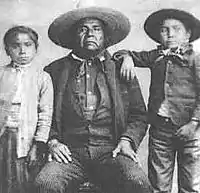 Various sombreros on display at the Museo de Arte Popular in Mexico City | |
| Type | Hat |
|---|---|
| Place of origin | Mexico |
A sombrero (Spanish for 'hat', lit. 'shadower'; Spanish: [somˈbɾeɾo]) is a type of wide-brimmed Mexican men's hat used to shield the face and eyes from the sun. It usually has a high, pointed crown; an extra-wide brim (broad enough to cast a shadow over the head, neck, and shoulders of the wearer) that is slightly upturned at the edge; and a chin strap to hold it in place.
In Mexico, this hat type is known as a sombrero de charro[1] ("charro hat", referring to the traditional Mexican horsemen). In Spanish, any wide-brimmed hat may be considered a sombrero.[2]
Design
Sombreros, like cowboy hats, were designed in response to the demands of the physical environment. The concept of a broad-brimmed hat worn by a rider on horseback can be seen as far back as the Mongolian horsemen of the 13th century, and in the Greek petasos two millennia before that.[3] In hot, sunny climates hats often have evolved wide brims. The exact origin of the Mexican sombrero is unknown, but it is usually accepted that the hat originated with mestizo cowboys in Central Mexico.[4] Although sombrero is usually taken to refer to the traditional Mexican headwear, the term sombrero predates this item of clothing, and has been applied to several differing styles of hat. Other types of hats known as sombrero can be found in South America and Spain, including the sombrero calañés, sombrero cordobés and sombrero de catite (Spain), and sombrero vueltiao (Colombia).
Cultural influence
Many early Texan cowboys adopted the Spanish and Mexican sombrero with its flat crown and wide, flat brim. Also called the poblano, these hats came from Spain.
The Mexican variation of the sombrero added an even wider brim and a high, conical crown. These are the hats worn by mariachi musicians and charros. Both types of sombreros usually include a barboquejo or chin strap.[2]
In the Western United States, the sombrero had a high conical or cylindrical crown with a saucer-shaped brim, highly embroidered and made of plush felt.[5]
In the Philippines, due to the influence from Spain brought about by the Manila galleon trade, the term has been assimilated into the Tagalog language in the form of sumbrero and now refers to any hat – from Mexican sombreros (as used in the English language) to baseball caps.[6]
The galaxy Messier 104 is known as the Sombrero Galaxy due to its appearance.[7] Similarly, Tampa Stadium was also known as "The Big Sombrero".
 Mexican Escaramuza charra wearing sombrero in a chareada.
Mexican Escaramuza charra wearing sombrero in a chareada. An Apache chief with a sombrero
An Apache chief with a sombrero Pancho Villa wearing a sombrero
Pancho Villa wearing a sombrero
See also
- Boss of the plains
- Cap
- Chupalla
- List of headgear
- Ranch
- Sun hat
- Vaquero
- Western wear
- Jarabe Tapatío, often referred to as the Mexican hat dance
References
- ↑ Valero Silva, José (1987). El libro de la charrería [The book of the charrería] (in Spanish). Mexico City: Gráficas Montealbán. p. 222.
- 1 2 Slatta, Richard W. (1996). The Cowboy Encyclopedia. ISBN 0-393-31473-1.
- ↑ Bender, Texan Bix (1994). Hats and the Cowboys Who Wear Them. Salt Lake City: Gibbs Smith, Publisher. p. 10. ISBN 1-58685-191-8.
- ↑ Bender, Texan Bix (1994). Hats and the Cowboys Who Wear Them. Salt Lake City: Gibbs Smith, Publisher. p. 11. ISBN 1-58685-191-8.
- ↑ Carlson, Paul Howard (2006). The Cowboy Way: An Exploration of History and Culture. p. 102. ISBN 0-89672-583-9.
- ↑ "Hat is Sumbrero in Tagalog". Archived from the original on 2014-02-22. Retrieved 2009-05-22.
- ↑ "Sombrero Galaxy: Hidden Double in a Hat". Space.com. 16 April 2014. Retrieved 2 June 2015.
External links
 Media related to Sombreros at Wikimedia Commons
Media related to Sombreros at Wikimedia Commons